Space Weather Modeling Framework (SWMF)

The Space Weather Modeling Framework (SWMF) is a versatile tool to study the Sun, Heliosphere, and planetary space environments, including that of the Earth.
The full SWMF suite, developed and maintained at the University of Michigan, is open-source at Github under the Apache 2 license. The only exception is the Polar Wind Outflow Model (PWOM, developed at NASA Goddard Space Flight Center) which is undergoing open-source process at NASA. Support and write access to the SWMF require registration under a user license.
When using the model, please add an acknowledgement “This work was carried out using the SWMF and BATS-R-US tools developed at the University of Michigan’s Center for Space Environment Modeling (CSEM). The modeling tools are available through the University of Michigan for download under a user license; an open source version is available here.
SWMF runs can be requested via the Community Coordinated Modeling Center (CCMC) at the NASA Goddard Space Flight Center through a user-friendly web interface.
For information about the SWMF User Meeting, please visit the SWMF User Meeting webpage.
The Framework
Software frameworks are utilized in problems that involve modeling of complex, multi-scale, and/or multi-physics problems. The SWMF tackles the wide range of temporal and spatial scales as well as the different physical processes governing the different heliophysics domains through a modular approach. Each physics domain is covered by a numerical model developed for that purpose. The framework couples several of these components together to execute the simulation in a setup best suited for the problem at hand.
The heart of the framework is the BATS-R-US versatile, high-performance, generalized magnetohydrodynamic code with adaptive mesh refinement that can be configured to solve the governing equations of ideal and resistive MHD, semi-relativistic, anisotropic, Hall, multispecies, and multi-fluid extended magnetofluid equations (XMHD) and non-neutral multifluid plasmas. The BATS-R-US is used to model several physics domains, and its high efficiency (faster than real time) is crucial for the success of the framework.
For space weather related simulations, the SWMF is typically used in two basic configurations: The Heliosphere Model and the SWMF/Geospace Model.
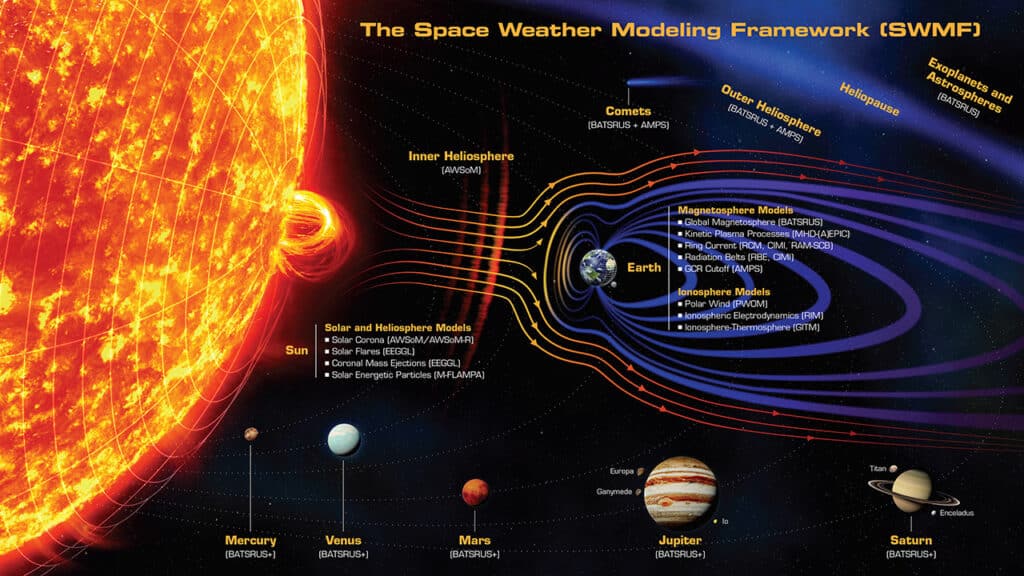
THE SUN AND THE SOLAR WIND
SWMF Heliosphere model consists of the Solar Corona (SC), Inner Heliosphere (IH) and Outer Heliosphere (OH) components, all modeled by AWSoM(-R). Coronal Mass Ejections can be generated by the Eruptive Event generator (EE) component based on various empirical models, such as the Gibson-Low (EEGGL) and Titov-Demoulin (EEGTD) fluxrope models.
The Alfven Wave Solar-atmosphere Model (AWSoM/AWSoM-R) describes the region where the hot, supersonic solar wind is generated – the solar corona from the bottom of the transition region out to about 20 Solar radii. The model self-consistently incorporates low-frequency Alfven turbulence powered by the Poynting flux from the solar photosphere. The boundary conditions for the MHD quantities are obtained from the Solar photospheric magnetograms. The model employs the solar coronal model based on the BATS-R-US code.
The Inner Heliosphere (IH) component extends from about 20 Solar radii to anywhere between the orbits of the Earth and Neptune. The model employs both BATS-R-US and AWSoM(-R), and can propagate interplanetary CMEs (ICMEs) from the Sun to the planets. Adaptive mesh refinement is used to increase the grid resolution along the path of the CME.
The Outer Heliosphere (OH) component typically extends from 30 au (astronomical units) inner boundary to a box covering -1500 to +1500 au in all directions. The OH model describes the interaction of the local interstellar medium (LISM) with the solar wind. Neutral hydrogen is either modeled as multiple fluids or kinetically using the Particle Tracker (PT) component.
CME generation: The Eruptive Event Generator (EE) component creates the initial and boundary conditions within the corona that produce a CME eruption. This can be done by inserting an unstable flux rope into the steady solar corona solution, or by inserting an arcade and applying shearing motion at the lower boundary of the corona model. The model parameters are selected to reproduce observed CME features close to the Sun. The EEGGL and EEGTD models provide data-driven CME simulations that are capable of reproducing the solar wind disturbances at 1 AU.
Solar energetic particle acceleration: The acceleration of energetic particles in a CME-driven shock and the subsequent transport processes are modeled using the M-FLAMPA module in SWMF. The distribution function of energetic particles are solved on a multitude of extracted magnetic field lines advecting with the background plasma. M-FLAMPA is fully coupled with the solar corona, inner heliosphere, and outer heliosphere components. The plasma and turbulence parameters along the magnetic field lines are extracted dynamically from the BATS-R-US solver. M-FLAMPA produces the flux of the energetic particles at any location in the heliosphere.
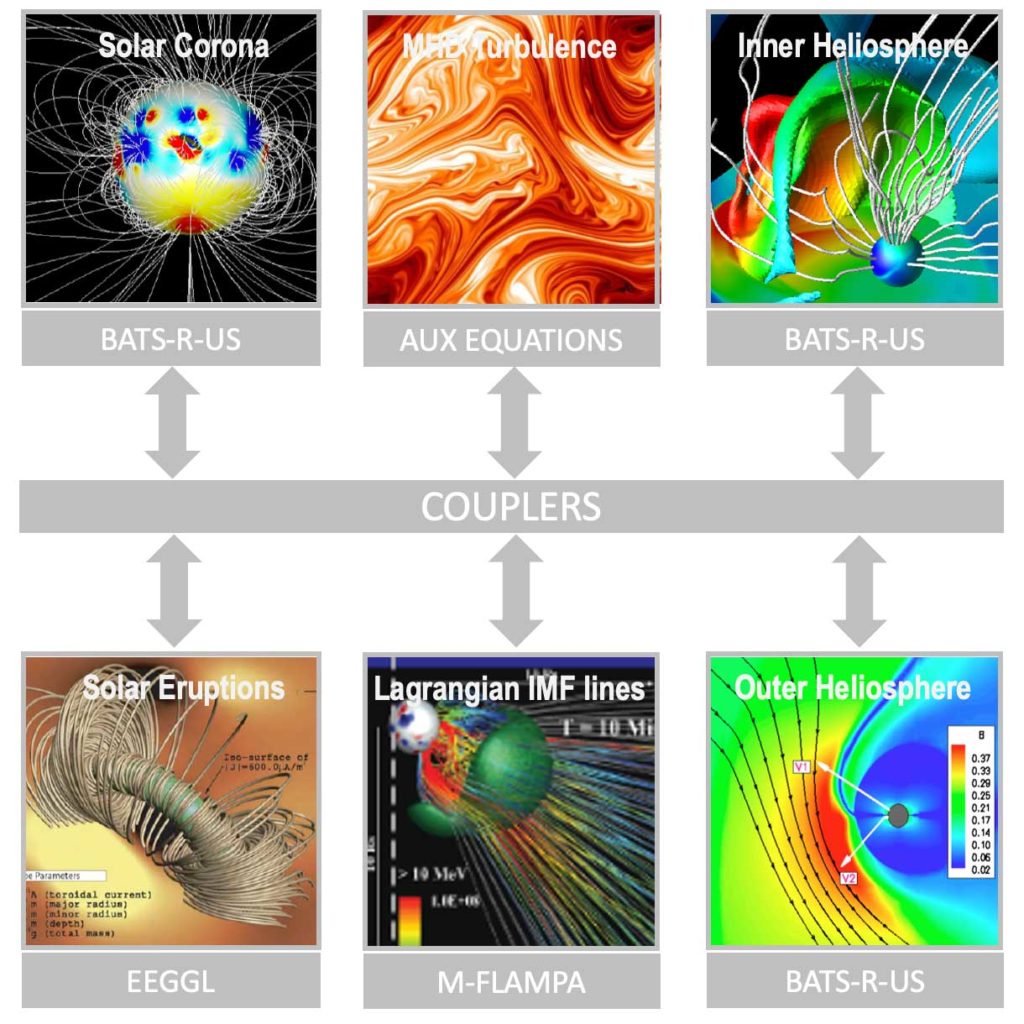
GEOSPACE MODELING
The SWMF/Geospace Model includes the basic elements of the tightly coupled magnetosphere-ionosphere system: the global magnetosphere, the inner magnetosphere, and the ionospheric electrodynamics. An operational version of the SWMF/Geospace model has been running 24/7 at the NOAA Space Weather Prediction Center (SWPC) since 2016.
The SWMF/Geospace configuration couples the Global Magnetosphere (GM) model based on BATS-R-US to the Ionospheric Electrodynamics (IE) model (Ridley Ionosphere Model, RIM) and the Inner Magnetosphere (IM) model (Rice Convection Model, RCM). The Global Magnetosphere model supplies near-body field-aligned currents to the ionosphere, which solves for the electric potential. This electric potential is returned to the magnetosphere to set the plasma tangential velocity at the inner boundary of the MHD domain.
The Rice Convection Model (RCM) receives its initial and boundary field and plasma conditions from BATS-R-US as well as electric field from the ionosphere. The RCM returns total plasma pressure and density to BATS-R-US inside the closed field line region, significantly improving the inner magnetosphere results of the MHD solution. The Geospace model is initialized by using the initial solar wind, IMF and F10.7 values for boundary conditions.
The SWMF/Geospace produces virtual magnetometer simulations during code execution using Biot-Savart integrals to find the total surface magnetic perturbation at an arbitrary point about the globe. Virtual satellite observations are created by mapping kinetic distributions from the inner magnetosphere and radiation belt modules to extract ring current and radiation belt flux distributions at arbitrary points about the inner magnetosphere.
The Dynamic Global Core Plasma Model (DGCPM) Plasmasphere Model can be coupled with the global magnetosphere and the Ridley Ionosphere Model to study the cold plasma populations in the inner magnetosphere. For this setup, the BATS-R-US is configured to use two fluids, one to represent the sources of ring current material (the solar wind and high latitude ionospheric outflow), and the other to represent the plasmasphere. The DGCPM passes the density of material in the plasmasphere to BATS-R-US, and RIM passes electric field information to both BATS-R-US and DGPCM while receiving current density form BATS-R-US.
The Radiation Belt Environment Model (RBM) can be included in the Geospace configuration. The RBM receives information from BATS-R-US and RIM, and solves for the energetic electron population in the radiation belts.
Transport of solar energetic particles and galactic cosmic rays in the magnetosphere is a kinetic process due to the large gyroradii of the high-energy particles. The variability of galactic cosmic rays in the magnetosphere is thus a combined effect of the IMF in the heliosphere and the geomagnetic field inside the magnetosphere; particles with energies below 100 MeV/n are effectively blocked by the Earth’s magnetosphere. The interaction of energetic particles in the magnetosphere is described in terms of rigidity (momentum/unit charge). Calculation of the cutoff rigidity is done using the Adaptive Mesh Particle Simulator (AMPS) that employs particle time-backward tracing starting from the altitude of 500 km.
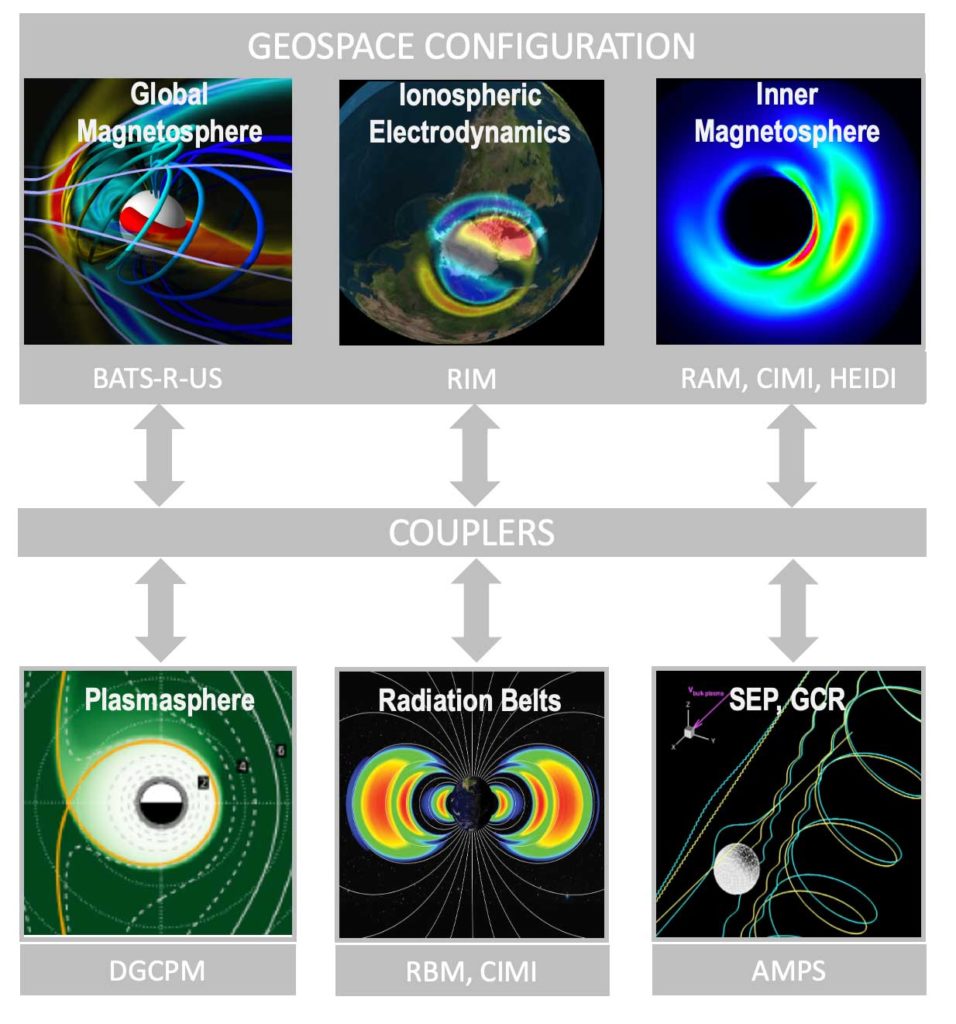
IONOSPHERE – MAGNETOSPHERE INTERACTION
The Polar Wind Outflow Model (PWOM) supplies the polar wind component in SWMF that calculates the transport of plasma from the ionosphere and sets the supply for the magnetosphere. This model solves the gyrotropic transport equations for multiple ion species from below the F2 peak to higher altitudes. The PWOM model includes various treatments of superthermal electron populations (photo, auroral, and secondary electrons), and has been expanded to move to a hybrid PIC description above 1000 km while maintaining a fluid description at lower altitudes.
The Global Ionosphere Thermosphere Model (GITM) is a 3-dimensional spherical code that models the Earth’s thermosphere and ionosphere system using a stretched grid in latitude and altitude. GITM explicitly solves for the neutral densities of O, O2, N(2D), N(2P), N(4S), N2, and NO as well as ion species O+(4S), O+(2D), O+(2P), O2+, N+, N2+, and NO+. GITM is coupled to the Geospace model to include the effects of the coupling to the neutral atmosphere. The GITM input includes F10.7, the Hemispheric Power Index, the IMF and solar wind parameters as well as the solar irradiance.
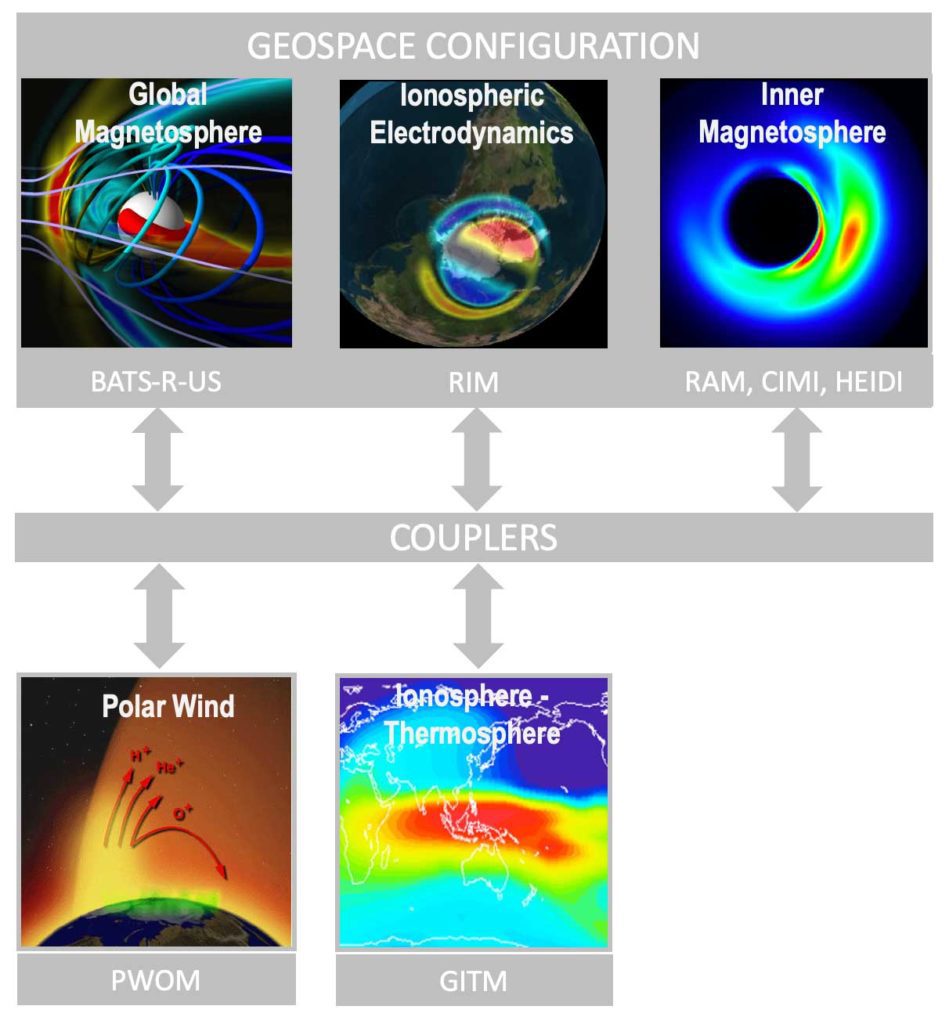
KINETIC PHYSICS
Solving the full kinetic equations in 7 dimensions (one temporal, 3 spatial and 3 velocity) in a global simulation is still not feasible on the current or even near future supercomputers.
The MHD with embedded PIC (MHD-EPIC) model couples the particle-in-cell (PIC) simulation with the SWMF components using an efficient parallel coupler that allows for different grids and different time steps and multiple PIC domains. To further improve the efficiency of the still computationally very expensive model, the MHD with an adaptively embedded PIC (MHD-AEPIC) algorithm decomposes the PIC grid into small blocks that can be activated and deactivated dynamically. A new PIC code, the Flexible Exascale Kinetic Simulator (FLEKS), is developed for MHD-AEPIC.
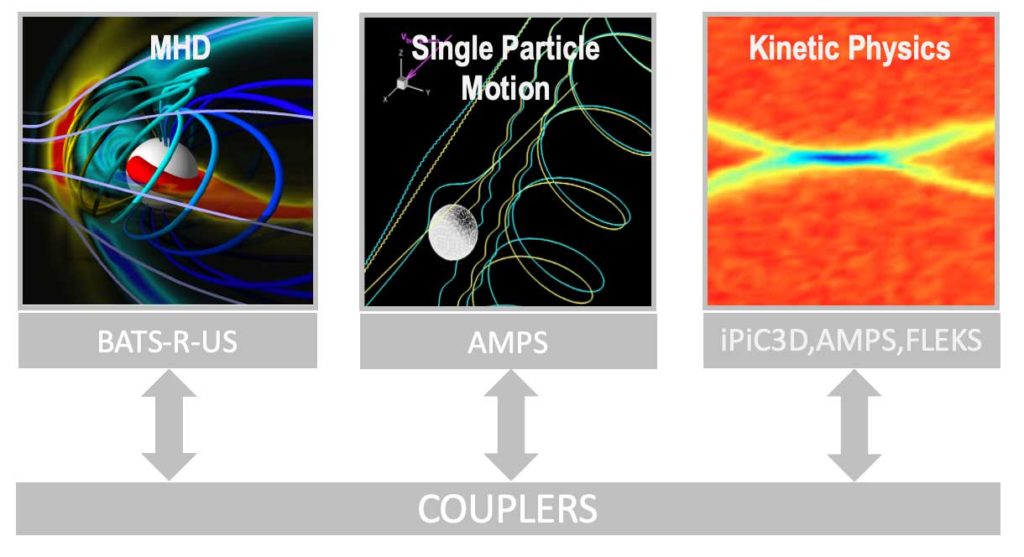
PLANETARY ENVIRONMENTS AND SOLAR ANALOGS
The SWMF simulation suite can be adapted to the space environments of most solar system planets. In addition to the basic MHD equations, there are various source and loss terms included in BATSRUS that change from application to application. Most relevant for giant planet magnetospheres (e.g., Jupiter and Saturn) is the capability of including various mass-loading processes (ionization, charge-exchange, dissociative recombination, etc.) arising from the internal plasma sources associated with planetary moons. In modeling planetary magnetospheres with an ionosphere, BATS-R-US is normally coupled to the Ionospheric Electrodynamics module to include the magnetosphere-ionosphere coupling. For planetary objects that do not possess a significant atmosphere/ionosphere, such as Mercury and Ganymede, the BATS-R-US MHD model has been extended to include the planetary interior as part of the simulation domain such that the influence of the electrical conductivity of the planetary interior on the space environment can be directly modeled.
The SWMF has been applied to Mercury, Venus, Mars, Jupiter, Saturn, and Uranus as well as to model comets and planetary moons including Io, Europa, Ganymede, Titan, and Enceladus. The SWMF suite has also been used to model the outer heliosphere and astrospheres.
FOR MORE INFORMATION
What Sustained Multi-Disciplinary Research Can Achieve: The Space Weather Modeling Framework
Tamas I. Gombosi, Yuxi Chen, Alex Glocer, Zhenguang Huang, Michael W. Liemohn, Ward B. Manchester, Tuija Pulkkinen, Nishtha Sachdeva, Qusai Al Shidi, Igor V. Sokolov, Judit Szente, Valeriy Tenishev, Gabor Toth, Bart van der Holst, Daniel T. Welling, Lulu Zhao, Shasha Zou, What Sustained Multi-Disciplinary Research Can Achieve: The Space Weather Modeling Framework, J. Space Weather and Space Climate, DOI: 10.1051/swsc/2021020, or arXiv:2105.13227.